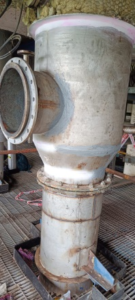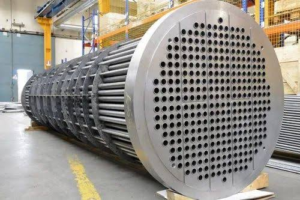Pressure Vessel Inspection & Maintenance
What is Pressure vessel?
A container designed to withstand internal and/or external pressure/loads. This pressure may be imposed by the application of heat from a direct or indirect source, or by any combination thereof. This definition includes heat exchangers, air coolers, columns, towers, unfired steam generators (boilers), and other vapor generating vessels that use heat from the operation of a processing system or other indirect heat source.



How to inspect pressure vessels?
Interior of vessel inspected for cracks, blistering, corrosion, deformation, or any other defects. Threads inspected to ensure the adequate number of threads are engaged on threaded connections. Openings leading to any external fittings or controls inspected to ensure they are free from obstruction.
Types of inspection for pressure vessel
- Internal inspection
- On-stream inspection
- External inspection
- Thickness examination
- CUI/CUF inspection
- Operator surveillance
External Inspection
A visual inspection performed from the outside of a pressure vessel to find conditions that could impact the vessel’s ability to maintain pressure integrity or conditions that compromise the integrity of the supporting structure (e.g., ladders, platforms, supports). The external inspection may be done either while the vessel is operating or while the vessel is out of service and can be conducted at the same time as an on-stream inspection.
Internal Inspection
An inspection performed from the inside of a pressure vessel using visual and/ or NDE techniques.
Risk- based inspection (RBI)
An inspection planning methodology that incorporates a risk assessment process that considers both the probability of failure and consequence of the failure. The methodology is primarily aimed at managing unacceptable risks, reducing loss of containment failures, and optimization of the inspection strategy.
Pressure vessels are susceptible to various types of damage by several mechanisms. Appropriate Inspection techniques for each of the credible damage mechanisms for each pressure vessel shall be part of the inspection plans. API RP 571 describes common damage mechanisms and inspection techniques to identify them. Some example damage mechanisms are as follows:
- a) General and localized metal loss and pitting corrosion (refer to API RP 571):
1) Sulfidation and high-temperature H2S/H2 corrosion
2) Oxidation
3) Microbiologically influenced corrosion
4) Naphthenic acid corrosion
5) Erosion/erosion-corrosion
6) Galvanic corrosion
7) Atmospheric corrosion
8) CUI
9) Cooling water corrosion
10) Boiler water and steam condensate corrosion
11) Soil corrosion
12) Ammonium bisulfide, ammonium chloride, and amine hydrochloride corrosion
13) CO2 corrosion
- b) Surface-connected cracking:
1) Mechanical fatigue
2) Thermal fatigue
3) Caustic stress corrosion cracking
4) Polythionic acid stress corrosion cracking
5) Wet H2S damage (sulfide stress cracking [SSC])
6) Chloride stress corrosion cracking
- c) Subsurface cracking:
1) Wet H2S damage (hydrogen-induced cracking [HIC]/ stress-oriented hydrogen-induced cracking
[SOHIC])
- d) High-temperature micro fissuring/micro void formation and eventual macro cracking:
1) High-temperature hydrogen attack
2) Creep and stress rupture
- e) Metallurgical changes:
1) Graphitization
2) Temper Embrittlement
3) Hydrogen Embrittlement
- f) Blistering:
1) Wet H2S damage (hydrogen blistering)


Our Other Services
- Rebound Hammer
- Ultrasonic Pulse Velocity
- Half Cell Potentials
- Concrete Core
- Carbonation
- Cover Meter Survey
- Pile Integrity Test
- Pile Dynamic Test
- Bridge Load Test
- Slab Load Test
- Cross Hole Sonic Test
- In-Situ Metallography (Replica)
- Portable Hardness Test (Rebound & UCI Method)
- Expert Metallurgy Consultant For Site
- Pressure Vessel Inspection & Maintenance
- Condition Assessment
- Remaining Life Assessment
- Fitness For Service
- Pipeline Inspection & Maintenance
- Tank Inspection & Maintenance
- IBR/Non IBR Fabrication
- Structural Health Assessment / Structure Audit
- Reactor Inspection As Per Factory Act





